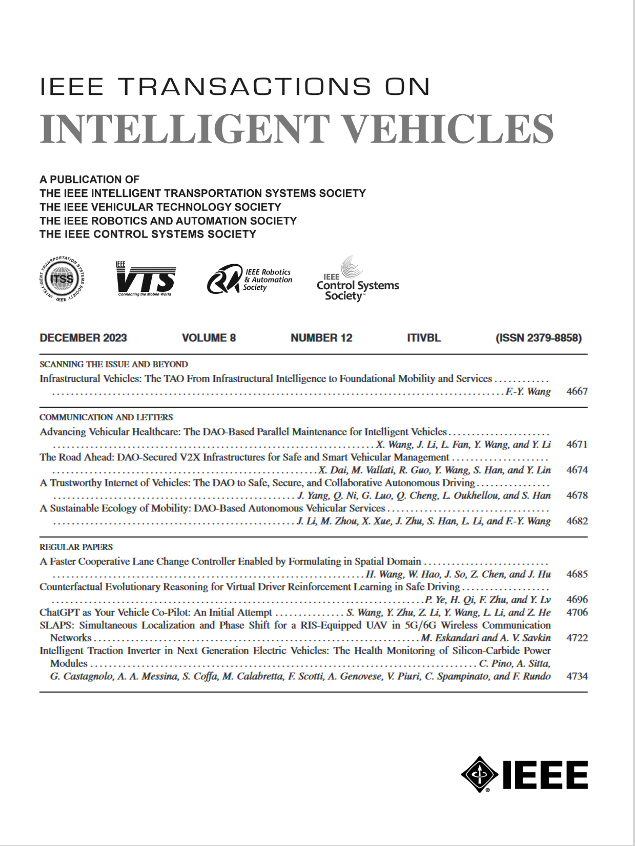Cooperative Communication via Automated Guided Vehicle and Unmanned Aerial Vehicle: A Distributed Collaborate Beamforming Method
IF 14.3
1区 工程技术
Q1 COMPUTER SCIENCE, ARTIFICIAL INTELLIGENCE
引用次数: 0
Abstract
The advantages of autonomy, stability, and high load capability make automated guided vehicles (AGVs) appealing for applications like intelligent transportation networks. Nevertheless, AGVs may face limitations in terms of flexibility and transmission efficiency. In this paper, we consider the scenario where unmanned aerial vehicles (UAVs) serve dual roles in enhancing the communications of AGVs. Specifically, one group of UAVs is employed to support AGVs in data transmission, while another group of UAVs equipped with computational resources, functions as aerial base stations (ABSs) for receiving and processing the collected data. Following this, we explore the collaborative deployment between AGVs and UAVs, and propose a highly efficient, low-interference, and energy-efficient uplink data transmission framework based on distributed collaborative beamforming. Correspondingly, we formulate a high-performance and low-interference transmission multi-objective optimization problem (HLTMOP) to reduce the transmission time and operation energy consumption of the AGVs and UAVs, while minimizing the total sidelobe levels toward the directions of all non-current receiving ABSs. Due to the NP-hardness of the HLTMOP, we propose a swarm intelligence algorithm, namely, improved multi-objective ant lion optimization (IMOALO), with three improved operators. Simulation results show that the proposed IMOALO algorithm performs better and can generate more excellent solutions than other benchmark algorithms.自动制导飞行器与无人机协同通信:一种分布式协同波束形成方法
自主、稳定和高负载能力的优势使自动导引车(agv)在智能交通网络等应用中具有吸引力。然而,agv在灵活性和传输效率方面可能面临限制。在本文中,我们考虑了无人机在增强agv通信方面的双重作用。其中,一组无人机支持agv进行数据传输,另一组无人机配备计算资源,作为空中基站接收和处理收集到的数据。在此基础上,探讨了agv与无人机协同部署,提出了一种基于分布式协同波束形成的高效、低干扰、高能效上行数据传输框架。相应地,我们制定了一种高性能、低干扰的传输多目标优化问题(htmop),以减少agv和无人机的传输时间和运行能耗,同时最小化所有非电流接收abs方向的总旁瓣电平。由于htltmop的np -硬度,我们提出了一种群智能算法,即改进的多目标蚂蚁狮子优化算法(IMOALO),其中有三个改进算子。仿真结果表明,与其他基准算法相比,本文提出的IMOALO算法性能更好,能够生成更优秀的解。
本文章由计算机程序翻译,如有差异,请以英文原文为准。
求助全文
约1分钟内获得全文
求助全文
来源期刊

IEEE Transactions on Intelligent Vehicles
Mathematics-Control and Optimization
CiteScore
12.10
自引率
13.40%
发文量
177
期刊介绍:
The IEEE Transactions on Intelligent Vehicles (T-IV) is a premier platform for publishing peer-reviewed articles that present innovative research concepts, application results, significant theoretical findings, and application case studies in the field of intelligent vehicles. With a particular emphasis on automated vehicles within roadway environments, T-IV aims to raise awareness of pressing research and application challenges.
Our focus is on providing critical information to the intelligent vehicle community, serving as a dissemination vehicle for IEEE ITS Society members and others interested in learning about the state-of-the-art developments and progress in research and applications related to intelligent vehicles. Join us in advancing knowledge and innovation in this dynamic field.
 求助内容:
求助内容: 应助结果提醒方式:
应助结果提醒方式:


